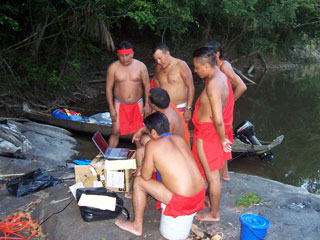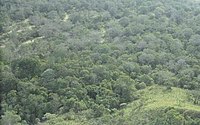The Amazon rainforest, also known as Amazonia, is one of the world's greatest natural resources. Because its vegetation continuously recycles carbon dioxide into oxygen, it has been described as the "Lungs of our Planet". About 20% of earth's oxygen is produced by the Amazon rainforest.
The Amazon rainforest gets its name from the Amazon River, the life force of the rainforest. The Amazon River begins in the Peruvian Andes, and winds its way east over the northern half of South America. It meets the Atlantic Ocean at Belem, Brazil. The main river is about 4,080 miles long. Its drainage basin covers 2,722,000 million square miles, and lies in the countries of Brazil, Columbia, Peru, Venezuela, Ecuador, Bolivia, and the three Guyanas. Sixteen percent of all the world's river water flows through the Amazon delta. Twenty eight billion gallons of water flow into the Atlantic every minute, diluting the salinity of the ocean for more than 100 miles offshore. The Amazon rainforest watershed is home to the world's highest level of biodiversity.
Amazonia receives about 9 feet of rain every year. Fifty percent of this returns to the atmosphere through the foliage of trees. Most of the Amazon River's water comes from the annual snowmelt high in the Peruvian Andes. Between June and October, the water level rises by 30 to 45 feet. Tens of millions of acres of rainforest are covered by water as the flood advances, reaching as far inland from the main channel as 12 miles.
Some 15 million years ago, the Amazon River flowed westward into the Pacific Ocean. When the South American plate moved into another tectonic plate, the Andes Mountains slowly rose up and blocked the flow of the river. As the river system backed up, freshwater lakes were formed, and the environment of the Amazon basin changed drastically. Then about 10 million years ago the river found its way eastward towards the Atlantic.
The Amazon rainforest is the drainage basin for the Amazon River and its many tributaries. The northern half of the South American continent is shaped like a shallow dish. About 1,100 tributaries, seventeen of which are over 1,000 miles long, drain into this depression. Whenever rain falls in the river basin, it all drains into Amazon rainforest and into the Amazon River. The Amazon is the largest river system in the world. At some points, the Amazon River is one mile wide, while at other points it can be thirty-five miles wide. At Belem, where the river flows into the Atlantic Ocean, it can be 200 to 300 miles across, depending on the season. Some of the animals that make their home here are river otters, freshwater river dolphins, turtles, piranha, manatees, electric eels, and a remarkable, giant air-breathing fish called the piraracu.
The world's largest tropical rainforest, Amazonia covers more than half of Brazil. The canopy of Amazonia is less studied than the ocean floor. Scientists believe that the canopy may contain half of the world's species. Over 500 mammals, 175 lizards and over 300 other reptiles species, and one third of the world's birds live in Amazonia. It is estimated that about 30 million insect types can be found here. Competition for survival is fierce. This may explain why over millions of years of evolution so many highly adapted species have evolved in the canopy of Amazonia. The most intense competition is between animals and plants. Both plants and animals have made adaptations to defend themselves from being eaten, and to overcome these defensive systems. Plants trap sunlight and turn it into energy for themselves and the herbivores of the canopy.
Some animals found in the canopy are the harpy eagle, which preys on monkeys, kinkajous, sloth, reptiles, and other birds. Sloths spend most of their lives in the treetops. Their diet of low nutrition leaves forces them to conserve energy, causing the sloth to spend 80% of its life resting. A large portion of a howler monkey's diet consists of leaves, which are hard to digest. Their metabolism is so low that they need to warm themselves up in the sunlight after a chilly night. Leaf-cutter ants are responsible for harvesting a sixth of the area's leaves, bringing leaf fragments to their underground nests. They play a critical role in the rainforest's ecosystem by pruning the vegetation, which stimulates new growth, and breaking down the leaves to renew the soil.
The Amazon rainforest consists of four layers or communities. Each layer has unique ecosystems, plants, and animals adapted to that system. The emergent layer is the tallest layer, where trees can be as tall as 200 feet, and rise well above the canopy. Here they are exposed to fluctuation of temperature, wind, and rainfall. The leaves are small and covered with a thick waxy surface to hold water. They take advantage of the wind by developing winged seeds that are blown to other parts of the forest. Trunks can be up to 16 feet around and braced by massive buttress roots. Some of the animals find everything they need to survive in the emergent layer and never leave it.
The main layer of the rainforest is the canopy. Most canopy trees have smooth, oval leaves that come to a point, known as a drip tip. This allows water to flow off the leaf quickly and prevents the growth of fungi, mosses, and lichens. The canopy's leaves are very dense and filter out about 80% of the sunlight. Many flowers and fruits grow in this layer. Epiphytes cover every available surface and bromeliads provide drinking water for the many canopy creatures, and breeding pools for tree frogs.
The understory only gets about two to five percent of the available sunlight. The plants find unique ways to adapt to this shadowy existence. Their solar-collecting leaves grow large, and are dark green in color. They don't often grow more than 12 feet in height. Because there is very little air movement, they rely on insects and animals to pollinate their flowers. Some grow large flowers and fruits low on their trunks to allow larger, non-climbing animals to eat and disperse their fruit. The largest concentrations of insects inhabit this layer.
The forest floor is the lowest layer and almost no plants grow here. Only about 2% of the sunlight filters through. The floor is littered with decomposing vegetation and organisms that are broken down into usable nutrients. Many nutrients are locked into this biomass. Tree roots stay close to the surface to access these nutrients. Large animals forage for roots and tubers, while insects like millipedes, scorpions, and earthworms use the litter as a source of food.
Despite all of its abundant richness, Amazonia's giant trees grow in the poorest of soil. The top two inches of the acidic soil contains 99% of the nutrients. Nine tenths of the forest's energy is stored in the leaves and tissues of the trees themselves. The forest floor is a porous mass that prevents minerals and nutrients from being washed away and lost. As soon as a tree falls, or a creature dies, decomposers begin to turn it into a food source and mulch. The vegetation to renew the cycle quickly absorbs the nutrients that are released. This is the tightest, most efficient ecosystem in nature. The destruction of one part of the system can spell the destruction of the whole system.
High temperatures and the amount of rain are the same throughout the year in Amazonia. The climate is warm and humid, with average temperatures around 79° F. The difference between day and night time temperatures is greater than those between seasons.
Today, more than 20% of the Amazon rainforest has been destroyed and is gone forever. The land is being cleared for cattle ranches, mining operations, logging, and subsistence agriculture. Some forests are being burned to make charcoal to power industrial plants. More than half of the world's rainforests have been destroyed by fire and logging in the last 50 years. Over 200,000 acres are burned every day around the world, or over 150 acres every minute. Experts also estimate that 130 species of plants, animals, and insects are lost every day. At the current rate of destruction, it is estimated that the last remaining rainforests could be destroyed in less than 40 years.
Native peoples of the Amazon rainforest have used different plants for centuries as cures and potions for their health and survival. Scientists are now discovering that many of the plants are sources for new drugs for AIDS, cancer, diabetes, arthritis, and Alzheimer's. Quinine, muscle relaxants, steroids, and caner drugs have already been discovered. Today 121 prescription drugs sold around the world come from plant-derived sources. Although 25% of all drugs are derived from rainforest ingredients, scientists have tested only 1% of tropical plants.
Another concern for Amazonia is the fate of it indigenous people. An estimated 10 million Indians were living in Amazonia about five hundred years ago. Today there are less than 200,000 indigenous peoples left in Amazonia. More than 90 tribes have been destroyed since the 1900's. Most of the shamans and medicine men remaining are 70 years old or more. With them goes a wealth of knowledge of medicinal species of plants and organisms.




